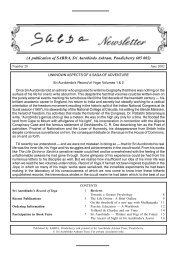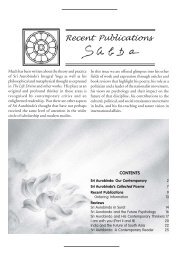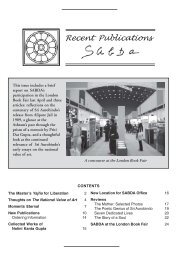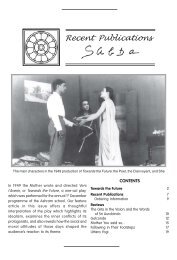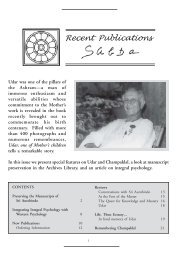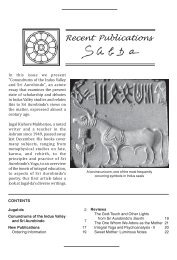Recent Publications - Sabda - Sri Aurobindo Ashram
Recent Publications - Sabda - Sri Aurobindo Ashram
Recent Publications - Sabda - Sri Aurobindo Ashram
Create successful ePaper yourself
Turn your PDF publications into a flip-book with our unique Google optimized e-Paper software.
12 <strong>Recent</strong> <strong>Publications</strong>analyse its problems and discuss men and matters as if hebelonged to this world. The excerpts presented here dealwith India and its problems and have a great contemporaryrelevance. Similar observations made by <strong>Sri</strong> <strong>Aurobindo</strong>on India and its problems can also be found in variousplaces in the two volumes of Nirodbaran’s correspondencewith <strong>Sri</strong> <strong>Aurobindo</strong>, which belongs to a slightly earlierperiod. An independent monograph on <strong>Sri</strong> <strong>Aurobindo</strong> onIndia as revealed through these volumes of Nirodbaranwould have been a valuable and timely publication onthe occasion of Nirod-da’s birth centenary.Twelve Years with <strong>Sri</strong> <strong>Aurobindo</strong> is represented here bya chapter entitled “The House of the Lord” from the book.For those who read this piece for the first time, a referenceto its source would have been very helpful. “<strong>Sri</strong> <strong>Aurobindo</strong>as Guru” is another exquisite piece that has the characteristicNirodbaran mark on it, disarmingly simple, andcandid. It is my personal feeling that it would have madeexcellent sense if this entire first section were publishedindependently as an anthology. There is a real need for aNirodbaran anthology. Besides, that would have helpedby making this book less massive.The second section begins with a very urbane andwell-crafted article reviewing Nirodbaran’s life andachievements by the editor of the volume. Iyengar’s“The Importance of BeingNirod” is a warm tribute tothe multifaceted personalityof Nirodbaran, and has thevirtue of having the right sizefor an article of that nature. It has also two articles onNirodbaran as a poet, the kinds of articles I would haveliked to see more of. K. D. Sethna’s “Inner Sight and InnerSong” is one of the best things I have ever read onNirodbaran as a poet. His classification of Nirodbaran’spoetic performance into classical, romantic and a unionof the two is a superb critical insight. Sethna gives us aframework which helps us to appreciate the rare quality ofNirodbaran’s poetry. I think with this article Sethna paysthe highest tribute to his poet-friend, of taking him seriouslyas a poet. Gautam Ghosal’s “Nirodbaran: Poet” is abrief essay which focuses on the poetic style of Nirodbaran.Richard Hartz’s “Nirodbaran, the Scribe” describes insome detail with the help of a few examples the trulystupendous work that was done by Nirodbaran as<strong>Sri</strong> <strong>Aurobindo</strong>’s scribe in the final six years of the compositionof Savitri. He succeeds in showing in what senseNirodbaran has indeed performed “a labour to the godsimpossible”. Nirodbaran’s service as a scribe ofThere is plenty here for the admirer and fan ofNirodbaran . . . a veritable feast of Nirodbaraniana.<strong>Sri</strong> <strong>Aurobindo</strong> is a splendid example of egoless offering ofone’s capacities and faculties in the service of the Divine,and all genuine lovers of Savitri are ever so grateful tohim for this act.Deshpande’s article is a leisurely appreciation of theclassic that Nirodbaran’s Twelve Years with <strong>Sri</strong> <strong>Aurobindo</strong>is and it succeeds in conveying to us its beauty and appealwhich has made it somewhat of a Bhagavat Purana for thedevotees of <strong>Sri</strong> <strong>Aurobindo</strong> and the Mother. He brings outclearly the unique position of the book in the growingbody of the <strong>Aurobindo</strong>nian literature.Manoj Das Gupta’s “Nirod-da” is a witty and lovingtribute to Nirodbaran and it brings out the nature of thespecial relationship which Nirodbaran had with<strong>Sri</strong> <strong>Aurobindo</strong>. Das Gupta shows that if God is “an eternalchild playing an eternal game” Nirodbaran was indeed acompanion to such a God. Sudha’s “Nirod-da” is one ofthe few articles which give us a peep into the early life ofNirodbaran. When Dilip Kumar Roy arranged forNirodbaran to have a meeting with the Mother during hisfirst visit to Pondicherry in early 1930, while on his wayback from London, he prepares himself for the meetingwith great earnestness. He writes, “That day I didn’t eatfish or meat in the hotel!” When he met her, he did pranamat her feet and she blessed him. He continues, “Then, byJove! She started looking atme and looking at me andlooking at me, smiling andsmiling and smiling…I didn’t know what to do.She poured smiles as if she had found a lost soul. … Sheremarked to her attendants, ‘He is very shy! He is veryshy!’” Through details like this Sudha succeeds increating a living portrait of Nirod-da. Bishakha Ray (translatedfrom the original Bengali) and Dimitry Melgunovpay their loving tributes to Nirodbaran in verse.Section three of this volume, according to the editor,contains articles from writers about their memorablecontacts with Nirodbaran. There are some good articles inthis section, such as Prema Nandakumar’s “Valmiki’sBharadwaja” and Shraddhavan’s “My Personal Contactswith Nirod-da” and Satyajit Ghosh’s “Nirod-da — ‘AnOutstretched Hand’ upon my Life”. In a few of thesearticles, Nirodbaran has been used as a mirror in which thewriters preen themselves. This, I guess, is to some extentunavoidable because when one begins to talk about one’scontact with a great man, one doesn’t realise when oneshifts the focus on to oneself from the great man. AnandaReddy’s “Glimpses of His Inner Quest” takes us to giddy



